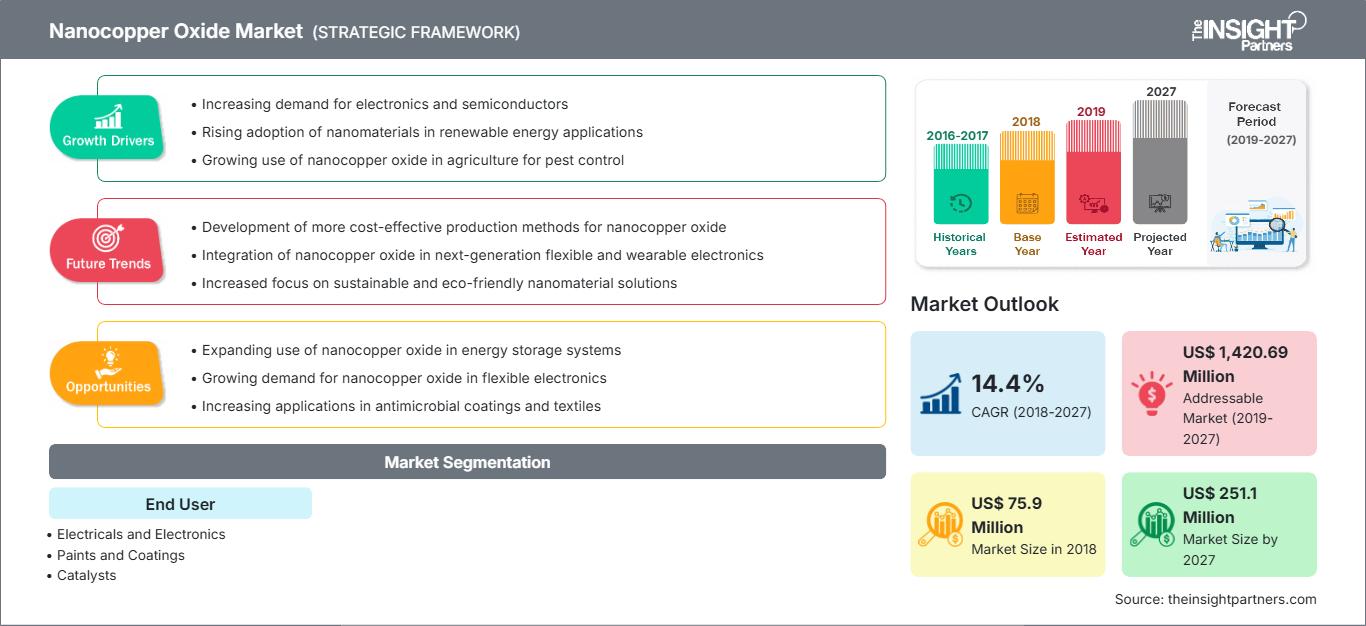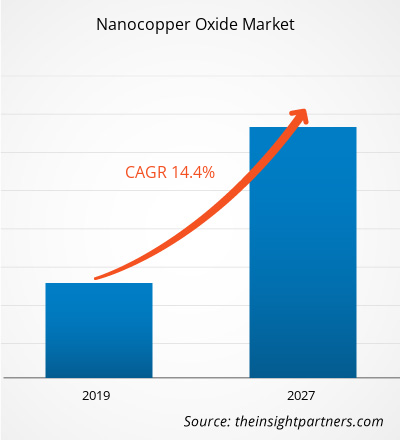[Forschungsbericht] Der Markt für Nanokupferoxid wurde 2018 auf 75,9 Millionen US-Dollar geschätzt und soll bis 2027 251,1 Millionen US-Dollar erreichen; von 2019 bis 2027 wird ein CAGR-Wachstum von 14,4 % erwartet.
Nanokupferoxid ist ein rötlich oder bräunlich-schwarzes Nanopartikel, das in der chemischen Industrie als Katalysator verwendet wird. Verschiedene Eigenschaften wie Zähigkeit und Duktilität, bessere Festigkeit und hohe elektrische Leitfähigkeit machen es ideal für vielfältige industrielle Anwendungen. Darüber hinaus gewinnt die Forschung an solchen Nanopartikeln an Dynamik. Daher treiben die zunehmenden F&E-Aktivitäten mehrerer Forschungseinrichtungen, Zentren und Industrien in den letzten Jahren das Marktwachstum voran. Der asiatisch-pazifische Raum wird im Prognosezeitraum voraussichtlich die am schnellsten wachsende Region für den Markt für Nanokupferoxid sein. Das enorme Wachstum industrieller und infrastruktureller Aktivitäten ist der Hauptgrund für das Wachstum des Marktes für Nanokupferoxid im asiatisch-pazifischen Raum. Einige der großen Volkswirtschaften der Region, wie China und Indien, bieten günstige Produktionsbedingungen. Um die steigende Nachfrage zu decken, drängen daher viele neue Unternehmen in den regionalen Markt. Darüber hinaus wird das starke Wachstum in zahlreichen Sektoren wie der Halbleiterindustrie, dem Baugewerbe und der Energiebranche die Nachfrage nach Elektroreparaturen sowie Lackier- und Beschichtungsstoffen in den kommenden Jahren erhöhen. Dies dürfte sich im Prognosezeitraum positiv auf das Wachstum des Marktes für Nanokupferoxid im asiatisch-pazifischen Raum auswirken.
Passen Sie diesen Bericht Ihren Anforderungen an
Sie erhalten kostenlos Anpassungen an jedem Bericht, einschließlich Teilen dieses Berichts oder einer Analyse auf Länderebene, eines Excel-Datenpakets sowie tolle Angebote und Rabatte für Start-ups und Universitäten.
Markt für Nanokupferoxid: Strategische Einblicke

- Holen Sie sich die wichtigsten Markttrends aus diesem Bericht.Dieses KOSTENLOSE Beispiel umfasst Datenanalysen, die von Markttrends bis hin zu Schätzungen und Prognosen reichen.
Sie erhalten kostenlos Anpassungen an jedem Bericht, einschließlich Teilen dieses Berichts oder einer Analyse auf Länderebene, eines Excel-Datenpakets sowie tolle Angebote und Rabatte für Start-ups und Universitäten.
Markt für Nanokupferoxid: Strategische Einblicke

- Holen Sie sich die wichtigsten Markttrends aus diesem Bericht.Dieses KOSTENLOSE Beispiel umfasst Datenanalysen, die von Markttrends bis hin zu Schätzungen und Prognosen reichen.
Auswirkungen der COVID-19-Pandemie auf den Markt für Nanokupferoxid
Der COVID-19-Ausbruch wirkte sich aufgrund von Lockdowns, Reisebeschränkungen und Betriebsschließungen negativ auf Wirtschaft und Industrie in verschiedenen Ländern aus. Die Chemie- und Werkstoffindustrie gehört zu den wichtigsten Branchen, die unter schweren Störungen wie Lieferkettenbeschränkungen und der Schließung von Produktionsanlagen leiden. Die Schließung verschiedener Anlagen und Fabriken in mehreren Ländern unterbrach die globalen Lieferketten und wirkte sich negativ auf die Umsätze der Elektro- sowie der Farben- und Lackindustrie aus. Der Verbrauch von Nanokupferoxid wurde ebenfalls durch die sinkende Nachfrage der Endverbraucherindustrien beeinträchtigt. Verschiedene Unternehmen haben bereits mögliche Verzögerungen bei Produktlieferungen und einen Einbruch der zukünftigen Produktverkäufe angekündigt. Mit der Einführung von Impfkampagnen wurden die Beschränkungen und Herstellungsaktivitäten jedoch gelockert.
Markteinblicke
Steigender Verbrauch von Nanokupferoxid in biomedizinischen Anwendungen
Metalloxid-Nanopartikel verfügen über eine einzigartige Struktur, Redox- und katalytische Eigenschaften, eine große Oberfläche, bessere mechanische Stabilität und Biokompatibilität. Daher haben mehrere Metalloxid-Nanopartikel in der biomedizinischen Therapie, der Biobildgebung und in Biosensoranwendungen großes Interesse geweckt. Die Synthese von Kupferoxid-Nanopartikeln mit verbesserter Größe und wünschenswerten Eigenschaften ist zum wichtigsten Schwerpunkt der biomedizinischen Industrie geworden. Im biomedizinischen Bereich stellt die „Sensorik“ aufgrund ihrer Nanogröße und außergewöhnlichen physikochemischen Eigenschaften ein wichtiges Anwendungsgebiet für Nanomaterialien dar. Mit dem technologischen Fortschritt hat jedoch ein Paradigmenwechsel hin zur „Theranostik“ stattgefunden. Kombination aus Sensor- und Therapiefunktionen auf einer einzigen Plattform. Kupferoxid-Nanopartikel lassen sich außerdem effizient in vivo und in vitro gezielt einsetzen. Zukünftig könnten CuO-NPs in biomedizinischen Anwendungen zur Identifizierung und Erkennung von Krankheiten oder Viren im menschlichen Körper eingesetzt werden. Mehrere Studien zeigen beispielsweise, dass CuO-NPs zur Erkennung des Grippevirus H1N1 eingesetzt werden können. Eine der interessantesten Innovationen in der Medizinbranche ist die Verwendung von Bettlaken mit CuO-NPs, da diese das Risiko mikrobieller Infektionen in Krankenhäusern verringern. Auch die Verwendung von CuO-NPs in Kissenbezügen und Bettzeug wird mit einer Verbesserung der Gesichts- und Fußhaut in Verbindung gebracht. Daher wird erwartet, dass die Nachfrage nach Nanokupferoxid in den kommenden Jahren mit steigenden Investitionen in Forschung und Entwicklung sowie zunehmenden Fortschritten in der Biomedizintechnik steigen wird.
Endnutzerbasierte Erkenntnisse
Nach Endnutzern ist der Markt für Nanokupferoxid in die Bereiche Elektrotechnik und Elektronik, Farben und Lacke, Katalysatoren, Energiespeicherung und Sonstiges unterteilt. Der Bereich Elektrotechnik und Elektronik hält den größten Marktanteil. Der Bereich Farben und Lacke wird im Prognosezeitraum voraussichtlich die höchste durchschnittliche jährliche Wachstumsrate (CAGR) verzeichnen. Nanobeschichtungen werden in Farben und Lacken verwendet, um feste Oberflächen zu versiegeln, zu schützen oder zu färben. Pigmente wie feste Nanopartikel spielen dabei eine entscheidende Rolle und werden seit Jahrtausenden verwendet. Heutzutage werden Nanomaterialien eingesetzt, um die Wirksamkeit von Farben zu erhöhen und ihnen neue Funktionalitäten zu verleihen. Es gibt bereits zahlreiche nanoverstärkte Farben auf dem Markt. In letzter Zeit ist die Nachfrage nach Nanokupferoxid aufgrund der steigenden Nachfrage nach innovativen Farben und Lacken in der Automobilindustrie leicht gestiegen. Daher treibt die wachsende Automobilindustrie den Markt für Farben und Lacke an, was wiederum das Wachstum des Marktes für Nanokupferoxid vorantreibt.
Die wichtigsten Akteure auf dem globalen Markt für Nanokupferoxid sind American Elements; Hongwu International Group Ltd.; Inframat Corporation; nanoComposix; Nanoshel LLC; Nanostructured & Amorphous Materials, Inc.; PlasmaChem GmbH; SkySpringNanomaterials Inc.; Strem Chemicals Inc.; und US Research Nanomaterials, Inc. Die wichtigsten Akteure auf dem Markt konzentrieren sich auf Strategien wie Fusionen und Übernahmen sowie Produkteinführungen, um die geografische Präsenz und die Verbraucherbasis weltweit zu erhöhen.
Markt für Nanokupferoxid
Die Analysten von The Insight Partners haben die regionalen Trends und Faktoren, die den Markt für Nanokupferoxid im Prognosezeitraum beeinflussen, ausführlich erläutert. In diesem Abschnitt werden auch die Marktsegmente und die geografische Lage von Nanokupferoxid in Nordamerika, Europa, dem asiatisch-pazifischen Raum, dem Nahen Osten und Afrika sowie Süd- und Mittelamerika erörtert.Umfang des Marktberichts über Nanokupferoxid
| Berichtsattribut | Einzelheiten |
|---|---|
| Marktgröße in 2018 | US$ 75.9 Million |
| Marktgröße nach 2027 | US$ 251.1 Million |
| Globale CAGR (2018 - 2027) | 14.4% |
| Historische Daten | 2016-2017 |
| Prognosezeitraum | 2019-2027 |
| Abgedeckte Segmente |
By Endverbraucher
|
| Abgedeckte Regionen und Länder | Nordamerika
|
| Marktführer und wichtige Unternehmensprofile |
|
Dichte der Marktteilnehmer für Nanokupferoxid: Verständnis ihrer Auswirkungen auf die Geschäftsdynamik
Der Markt für Nanokupferoxid wächst rasant, angetrieben durch die steigende Endverbrauchernachfrage aufgrund von Faktoren wie sich entwickelnden Verbraucherpräferenzen, technologischem Fortschritt und einem stärkeren Bewusstsein für die Produktvorteile. Mit steigender Nachfrage erweitern Unternehmen ihr Angebot, entwickeln Innovationen, um den Verbraucherbedürfnissen gerecht zu werden, und nutzen neue Trends, was das Marktwachstum weiter ankurbelt.

- Holen Sie sich die Markt für Nanokupferoxid Übersicht der wichtigsten Akteure
Berichts-Spotlights
- Fortschreitende Branchentrends im Nanokupferoxid-Markt helfen den Akteuren bei der Entwicklung effektiver langfristiger Strategien
- Geschäftswachstumsstrategien in entwickelten und sich entwickelnden Märkten
- Quantitative Analyse des Marktes von 2017 bis 2027
- Schätzung der globalen Nachfrage nach Nanokupferoxid
- Porters-Analyse zur Veranschaulichung der Wirksamkeit von Käufern und Lieferanten in der Branche
- Jüngste Entwicklungen zum Verständnis des wettbewerbsorientierten Marktszenarios
- Markttrends und -aussichten sowie Faktoren, die das Marktwachstum vorantreiben und hemmen
- Unterstützung im Entscheidungsprozess durch Hervorhebung von Marktstrategien, die das kommerzielle Interesse untermauern und zum Marktwachstum führen
- Die Marktgröße des Nanokupferoxids an verschiedenen Knotenpunkten
- Detaillierte Übersicht und Segmentierung des Marktes sowie die Branchendynamik
- Marktgröße in verschiedenen Regionen mit vielversprechenden Wachstumschancen
- Historische Analyse (2 Jahre), Basisjahr, Prognose (7 Jahre) mit CAGR
- PEST- und SWOT-Analyse
- Marktgröße Wert/Volumen – Global, Regional, Land
- Branchen- und Wettbewerbslandschaft
- Excel-Datensatz
Aktuelle Berichte
Verwandte Berichte
Erfahrungsberichte
Grund zum Kauf
- Fundierte Entscheidungsfindung
- Marktdynamik verstehen
- Wettbewerbsanalyse
- Kundeneinblicke
- Marktprognosen
- Risikominimierung
- Strategische Planung
- Investitionsbegründung
- Identifizierung neuer Märkte
- Verbesserung von Marketingstrategien
- Steigerung der Betriebseffizienz
- Anpassung an regulatorische Trends




















 Kostenlose Probe anfordern für - Markt für Nanokupferoxid
Kostenlose Probe anfordern für - Markt für Nanokupferoxid